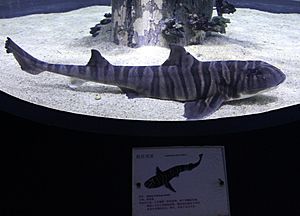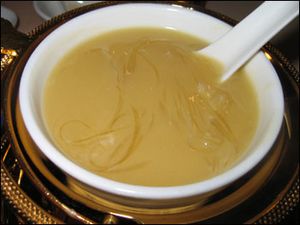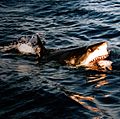Shark facts for kids
- For the NHL team, see San Jose Sharks
Quick facts for kids Sharks |
|
|---|---|
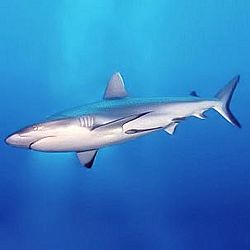 |
|
| Grey reef shark (Carcharhinus amblyrhynchos) | |
| Scientific classification | |
| Kingdom: | |
| Phylum: | |
| Class: | |
| Subclass: | |
| Superorder: |
Selachimorpha
|
Sharks are a superorder of fish called the Selachimorpha. They, like other Chondrichthyes, have skeletons made of cartilage instead of bone. Cartilage is tough, rubbery material which is less rigid than bone. Cartilaginous fish also include skates and rays.
There are more than 350 different kinds of sharks, such as the great white and whale sharks. Fossils show that sharks have been around for 420 million years, since the early Silurian.
Most sharks are predators, meaning they hunt and eat fish, marine mammals, and other sea creatures. However, the largest shark eats krill, like whales. This is the whale shark, the largest fish in the world. Some common kinds of shark include the hammerhead shark, the great white shark, the tiger shark, and the mako shark.
Contents
Characteristics
Sharks come in many different shapes and sizes, but most are long and thin (also called streamlined), with powerful jaws. Their teeth are constantly replaced throughout their lives. Sharks eat so violently they often break a few teeth, so new teeth grow continuously in a groove just inside the mouth and move forward from inside the mouth on "conveyor belts" formed by the skin in which they are attached to. In its lifetime, a shark can lose and regrow as many as 30,000 teeth.
Even with all those teeth, though, sharks can not chew. So they bite their prey and jerk it around so they can pull of a chunk to swallow. The chunks of food that a shark swallows ends up in its stomach, where they are digested. This is pretty slow, however, so a meal might take several days to digest. This is why a shark does not eat every day.
Sharks have different-shaped teeth, depending on what they eat. For instance, some sharks have sharp, pointy teeth, while bottom dwelling sharks have cone-shaped teeth for crushing shells. Because there are so many different kinds of sharks, and because each kind has its own kind of special teeth, many people enjoy collecting shark teeth. Shark teeth collectors can guess how large a shark was by measuring the shark tooth! First, they measure the length of the tooth in inches. Every inch of tooth equals 10ft of shark length: so if a shark tooth is 2 inches long, the tooth came from a shark that was 20 ft long! Even more terrifying is that some of the Megalodon teeth are 6 inches long so that suggets a shark 60 feet long.
Sharks have skin covered in millions of tiny teeth-like scales that point to the tail. If you rub along a shark towards the tail, it would feel smooth, but if you rub the other way, it would be rough. Sharks' teeth can be 20 times as big as human teeth and they can grow back if they are lost.
Fins
The fins of sharks are used for stabilizing, steering, lift and swimming. Each fin is used in a different manner.
There are one or two fins present along the dorsal midline called the first and second dorsal fin. These fins help the shark from constantly rolling around. These two fins may, or may not have spines. When spines are present, they are used for defensive purposes, and may also have skin glands with them that produce an irritating substance.
The pectoral fins are located behind the head and extend outwards. These fins are used for steering during swimming and help to provide the shark with lift.
The pelvic fins are located behind the pectoral fins, near the claoca, and are also stabilizers.
Not all sharks have anal fins, but if they do have them, they are found between the pelvic and caudal fins.
The tail region itself consists of the caudal peduncle and the caudal fin. The caudal peduncle sometimes has notches known as "precaudal pits", which are found just ahead of the caudal fin. The peduncle may also be horizontally flattened into lateral keels. The caudal fin has both, an upper lobe, and a lower lobe, that can be of different sizes and the shape depends of which species the shark is. The primary use of the caudal fin is to provide a "push" while the shark swims. The upper lobe of the caudal fin produces the most amount of the push, and usually forces the shark downwards. The pectoral fins and the shape of the body (like an airfoil) work together to counter this force. The strong, non-lunate caudal fin in most benthic shark species allows the shark to swim close to the seabed (such as the Nurse shark). However, the fastest swimming sharks (such as the Mako sharks) tend to have lunate-shaped (crescent-shaped) caudal fins.
Senses
Smell
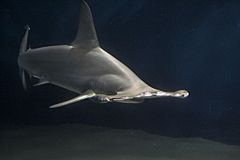
Sharks have keen olfactory sense organs in the short duct between the front and back nasal openings. They can detect blood from miles away: as little as one part per million of blood in sea water may be enough.
Sharks have the ability to determine the direction of a given scent based on the timing of scent detection in each nostril. This is similar to the method mammals use to determine direction of sound.
They are more attracted to the chemicals found in the intestines of many species, and as a result often linger near or in sewage outfalls. Some species, such as nurse sharks, have external barbels that greatly increase their ability to sense prey.
Sight
Shark eyes are similar to the eyes of other vertebrates, including similar lenses, corneas and retinas. Their eyesight is well adapted to the marine environment. They can contract and dilate their pupils, like humans, something no teleost fish can do. A tissue behind the retina reflects light back, thereby increasing sight in darker waters.
Sensing electric current
Sharks have tiny holes all over the shark's snout, especially between the eye and the tip of the snout. In them are which are nerve receptors called the ampullae of Lorenzini. p23 They can sense electricity in the water. Animal in the water give off electricity: every time an animal's heart beats or it moves, tiny currents of electricity are made. These tiny electric currents make signals that travel through water and get sensed. Sharks may use this sense when they catch their prey, even more than they use their sight.
Hearing
Although it is hard to test sharks' hearing, they may have a sharp sense of hearing and can possibly hear prey many miles away. A small opening on each side of their heads (not the spiracle) leads directly into the inner ear through a thin channel.
Lateral line
The lateral line detects changes in water pressure. It is open to the environment by a line of pores. This and the sound-detecting organs are grouped together as the 'acoustico-lateralis system', because they have a common origin. In bony fish and tetrapods the external opening into the inner ear has been lost.
This system is found in other fish as well. It detects motion or vibrations in water. The shark can sense frequencies in the range of 25 to 50 Hz.
Prehistoric sharks
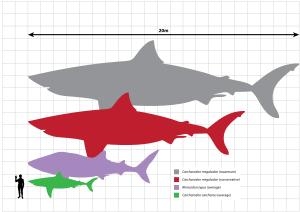
Because sharks have skeletons made of cartilage, they do not fossilize easily. That's because cartilage is softer than bone and falls apart before fossilizing. However, teeth are harder, and if that is not enough, they are shed throughout a shark's lifetime. Therefore, shark teeth are one of the most common fossils.
Sharks existed for at least two hundred million years before the dinosaurs. The earliest shark fossils were scales, so could it be that the earliest sharks were toothless? We are not sure. Early sharks did not look like sharks of today. For example, the upper snout of modern sharks is longer than the lower jaw. But in early sharks, they were the same length.
The first modern-looking sharks appeared in the Age of Dinosaurs. Sharks back then were preyed on by giant sea reptiles.
Just a few million years ago, a giant shark called Megalodon swam in the seas. It was 18 meters long, twice as long as the closely-related great white shark, and it ate whales. Megalodon died out 1.6 million years ago.
Reproduction
About 70% of all known shark species give birth to live young, with the gestation period lasting from 6 to 22 months.
Pups are born with a full set of teeth, and are capable of taking care of themselves. Once born, they quickly swim away from their mothers, who sometimes feed on the pups. Litters vary from one or two pups (Great white shark) to one hundred pups (Blue shark and Whale shark).
Oviparity
Some sharks are oviparous, laying their eggs in the water. Shark eggs (sometimes called "mermaid's purses") are covered by a tough, leathery membrane. The egg has a yolk that feeds the embryo, very much like a chicken egg.
Ovoviviparity
Most sharks are ovoviviparous, meaning the eggs hatch inside the female's body, with the babies developing within the mother, but there is no placenta to nourish the pups. Instead the young feed on the egg's yolk. The pups eat any unfertilized eggs and sometimes each other. Very few pups in a litter survive until birth due to this form of sibling cannibalism. Great white sharks, Mako sharks, Nurse sharks, Tiger sharks, and Sand tiger sharks reproduce this way.
Viviparity
Some sharks are viviparous, meaning that the females give live birth: the eggs hatch inside the female's body, and the babies are fed by a placenta. The placenta helps transfer nutrients and oxygen from the mother's bloodstream and transfers waste products from the baby to the mother for elimination. Examples of viviparous sharks include the Bull sharks, the Whitetip reef sharks, the Lemon sharks, the Blue sharks, the Silvertip sharks, and the Hammerhead sharks. Although long thought to be oviparous, Whale sharks are viviparous, and pregnant females have been found containing hundreds of pups.
New shark discoveries
New sharks are still being found. Dave Ebert has found ten new species in a Taiwan market alone. Over the past three decades he has named 24 new species. They include sharks, rays, sawfish and ghost sharks – these cartilaginous fish are all related.
Fishing
Some sharks are not endangered, but some are hunted for food (like shark fin soup) or sport fishing. In 2013 five species of shark, along with two species of manta ray, received international protection as part of the Convention on International Trade in Endangered Species.
It is estimated that 100 million sharks are killed by commercial and recreational fishing. Sharks are a common seafood in many places, including Japan and Australia.
In the Australian state of Victoria, shark is the most commonly used fish in fish and chips, in which fillets are battered and deep-fried or crumbed and grilled. In fish and chip shops, shark is called "flake".
In India, small sharks or baby sharks (called sora in Tamil language, Telugu language) are sold in local markets. Since the flesh is not developed, cooking the flesh breaks it into powder, which is then fried in oil and spices (called sora puttu/sora poratu). The soft bones can be easily chewed. They are considered a delicacy in coastal Tamil Nadu.
Related Pages
Images for kids
-
A collection of Cretaceous shark teeth
-
Shark fossil, Lebachacanthus senckenbergianus, at Permian period
-
The teeth of tiger sharks are oblique and serrated to saw through flesh
-
The dermal denticles of a lemon shark, viewed through a scanning electron microscope
-
The claspers of male spotted wobbegong -
Unlike many other sharks, the great white shark is not actually an apex predator in all of its natural environments, as it is sometimes hunted by orcas
-
A sign warning about the presence of sharks in Salt Rock, South Africa
-
Shark-themed nose art, made popular by the Flying Tigers (pictured), is commonly seen on military aircraft.
See also
 In Spanish: Selachimorpha para niños
In Spanish: Selachimorpha para niños


